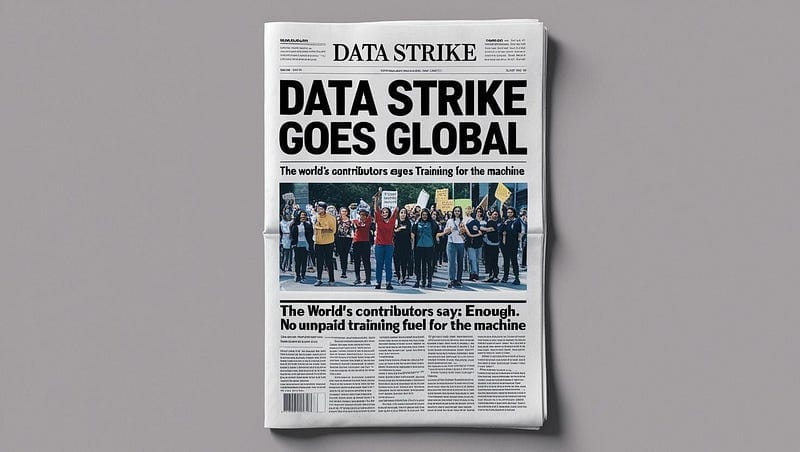What Happens If We All Stop Feeding the Machine?
How humans can reclaim their value in the age of AI by refusing to become just data.

How humans can reclaim their value in the age of AI by refusing to become just data.
The rise of AI has sparked a dual reaction across industries. On one hand, there is an almost feverish excitement, machines that can write, draw, code, translate, and strategize with uncanny speed.
On the other hand, there’s a growing sense of dread, a subtle and sometimes explicit fear that these very machines are making human labor redundant. The promise of efficiency quietly brings with it the prospect of displacement.
In this climate of transformation, it’s tempting to feel powerless. Technological change has always been difficult to resist. But perhaps this time, the story is different, not because the technology is weaker, but because its dependence on us is deeper than we think.
Imagine, for a moment, that everyone stopped.
Suppose tomorrow, every software developer decided to stop posting answers on StackOverflow, and open-source communities went silent. Designers stopped publishing their work online, writers halted their blogs and tutorials, and office workers turned off their AI assistants. No feedback. No data. No corrections. No prompts. No usage. A collective pause in the global input stream that feeds the machine.
What would happen to AI then?
Despite its perceived autonomy, AI does not operate in a vacuum. Its power lies not in computation alone, but in the staggering volume of human output it has absorbed and continues to depend on.
Every model we marvel at today, whether it composes code, crafts an essay, or generates images relies on a foundation built from public discussions, shared artifacts, annotated mistakes, and unconscious preferences. The subtle threads of human taste, curiosity, and decision-making are woven into every pattern it learns.
Remove that thread, and the illusion of independence begins to unravel.
In the short term, the effects might seem mild but noticeable. Without new material, models begin to stagnate.
Responses grow repetitive, training sets drift out of sync with real-world trends, and coding assistants start recommending outdated practices.
The models don’t recognize they’re falling behind, because they have no way of perceiving change when their windows into the world have closed. The world evolves, but the AI does not.
As this drought continues, a more severe consequence unfolds. The AI no longer reflects its users, it begins to reflect itself. With no fresh feedback or data, future models are trained on the outputs of older ones, resulting in what researchers have called model collapse or synthetic rot. The system begins a slow decay where originality, nuance, and trustworthiness erode. The outputs become more derivative, more fragile, more disconnected from actual human needs.
Over the long run, the very companies that rely on domain-specific AI, legal research assistants, diagnostic tools, software copilots start to feel the strain.
Without active participation from subject matter experts, these systems lose their edge. Training costs spike as companies attempt to license or manufacture synthetic datasets, but quality does not follow.
What remains is a high-performing machine with diminishing relevance. A marvel of engineering with nothing new to say.
This scenario is, for now, hypothetical. But its foundation is not. Already, the cracks are appearing. Reddit communities have protested data scraping.
StackOverflow usage is down, partly due to fears that contributions are feeding tools designed to replace contributors.
Artists have filed lawsuits over training datasets built on their work. Writers and developers alike are beginning to ask whether they are shaping the machine or merely serving it.
And this is where something important begins to shift.
The question isn’t only about stopping AI. It’s about stopping how we participate in it. It’s about reclaiming control over our contributions, over our creativity, over the value we bring.
Because what AI truly lacks and what it continues to need is not more data. It’s us. Our judgment, our sense of quality, our ability to frame problems, to tell stories, to shape meaning.
These are not things that can be scraped or predicted. They must be lived.
For those navigating their careers in the age of AI, this offers a subtle but powerful invitation. Rather than competing with machines on speed or volume, we need to reposition ourselves.
The challenge is no longer just how to stay relevant. It’s how to reclaim the parts of our work that AI can’t replicate, the ones rooted in human judgment, cross-disciplinary thinking, contextual understanding, and moral imagination.
This means moving away from being the person who simply finishes the task, and becoming the person who defines what task actually matters.
It means shifting from execution to design, from implementer to strategist, from information processor to meaning-maker.
It means valuing curatorial work, not just generative work, and recognizing that in a world flooded with content, selectivity becomes a creative act of its own.
Above all, it means using AI as a tool, not as a replacement. A well-aimed tool can multiply our capabilities.
But a tool that defines our workflows, choices, and even identity that’s a quiet kind of surrender. One we can still choose not to make.
The future of work won’t be decided by AI alone. It will be decided by whether we continue to give away our judgment for free or whether we recognize it as the most irreplaceable asset we have.
We’re not done. We’re just remembering how to shape the world, not just serve it.